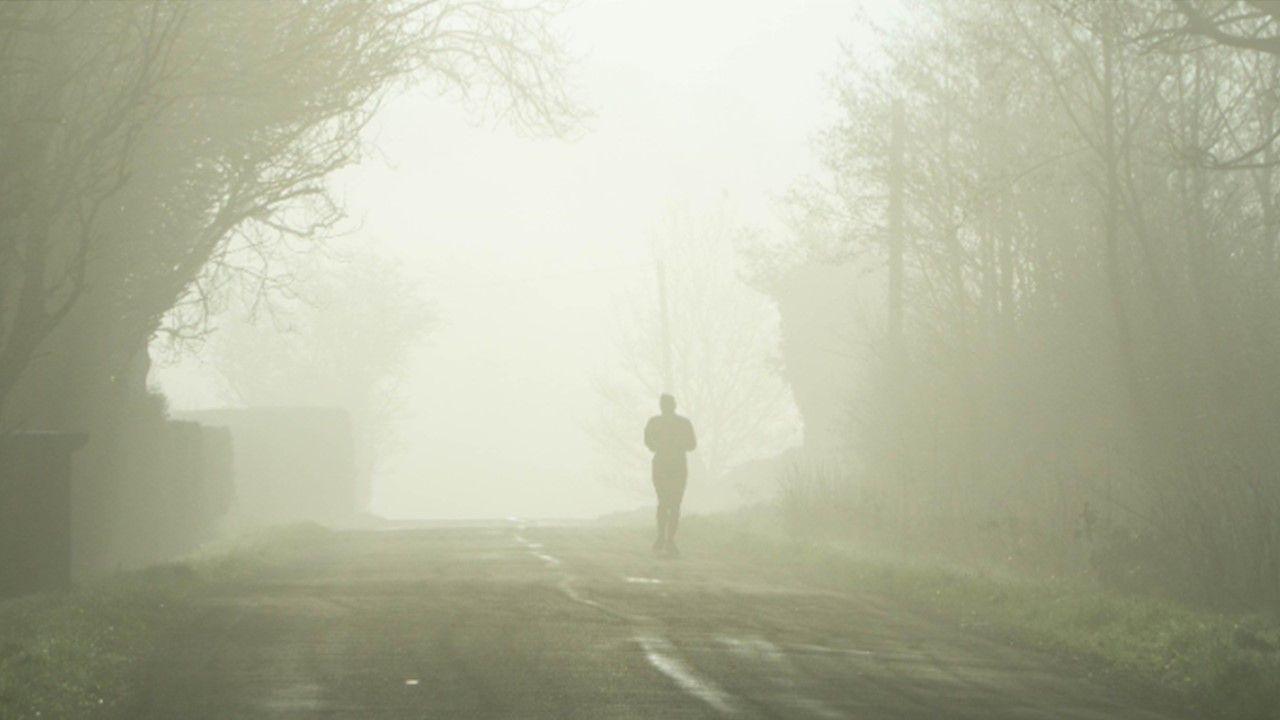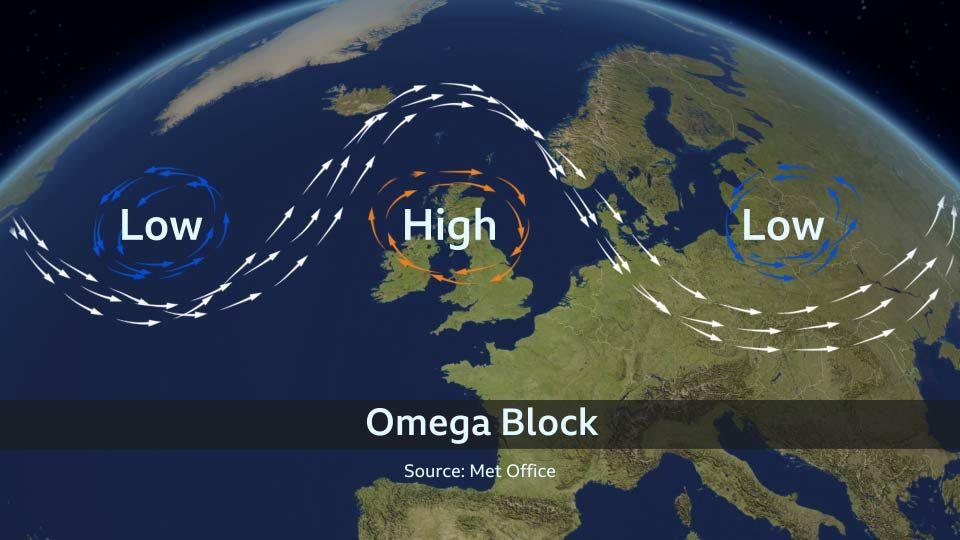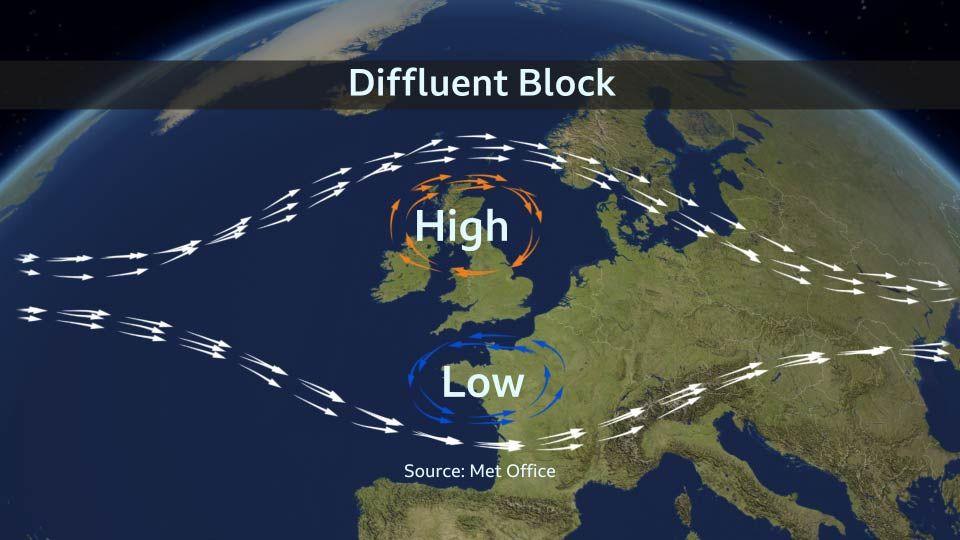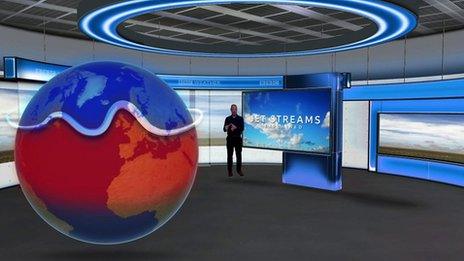Why are we basking in endless spring sunshine?

- Published
If you are wondering why the UK is bathed in relentless sunny weather at the moment the answer is quite simple - it's down to something called an Omega blocking pattern.
While we are used to weather systems largely being driven across the Atlantic one after the other, bringing a variety of conditions, sometimes the pattern just gets stuck.
This means the weather becomes static over a particular area and any changes happen very slowly.
Blocked patterns can bring extremes depending on where and when they develop - high temperatures and sunshine in the summer or endless cloud in the winter.
And it is one of those jams that has created the current situation in the UK.
It's all down to the jet stream
Usually weather systems cross the Atlantic and then the UK as they journey from west to east around the globe in the northern hemisphere. They are responsible for most of our rain and strong winds.
The systems are driven by winds 10km (6miles) up in the atmosphere, known as the jet stream which is like a river of faster flowing air.
As the jet speeds up or slows down, our high and low pressures form at the surface and these shape the changes in our day-to-day weather.
However, from time to time the jet stream can be disrupted by a 'blocked weather pattern', which is what we are experiencing now.

A lone figure walks along a foggy country lane on a gloomy day
If we get stuck under high pressure in the summer you can get hot and dry spells, like the summer of 1976 where temperatures stayed in the 30Cs and there was no rain for weeks on end.
It is important to remember that high pressure usually means dry weather, but not always sunny weather.
In the winter when cloud gets trapped under an area of high pressure - known as 'anticyclonic gloom' - we end up with unrelenting dull days.
It is also important to remember that low pressure means wet weather. If the pattern of the block leads to low pressure being stuck over the UK, this can lead to lots of rain and flooding.
The Omega block

In an Omega block set-up like this one, high pressure develops and sits in one place for a long time
There are two set-ups which disrupt the usual eastwards run of weather systems, called the 'Omega' and the 'Diffluent' blocks.
Both happen when the jet stream weakens. The river of air slows down and then starts to meander northwards and southwards, forming ridges or troughs.
The Omega block is named for its resemblance to the Greek letter, Omega, which results in a persistent high pressure with low pressure either side.
It has been so dry for the last few weeks in March because high pressure has been stationary near the UK. The rain has to fall somewhere though and this blocking pattern has left low pressure stuck over Iberia, which is why it has been so wet in Spain and Portugal recently.
An Omega block is believed to have been a contributing factor to the devastating flooding in Valencia in autumn 2024.
The Diffluent Block

A Diffluent block can also lead to high or low pressure stuck in the same place
The Diffluent block is different because the jet stream splits. One branch of the jet stream leads to high pressure forming in the ridge to the north. The other branch leads to low pressure forming in the trough to the south. It is still a stationary weather pattern that leads to the same type of weather lasting for a long period of time.
Are blocking patterns happening more often and is climate change having an impact?
The UK weather is affected by the polar jet stream. This jet stream is powered by temperature contrasts between the tropics and the Arctic. Arctic regions are warming particularly rapidly due to climate change thus reducing this temperature contrast.
Scientists believe that due to global warming the polar jet stream is weakening. Some evidence suggests that this weakening could be leading to more of these blocked weather patterns. It is a complex area and there is also evidence to suggest otherwise.
As studies continue, many extreme weather events are starting to be linked to changes in the jet stream, like the 2003 European heatwave which killed tens of thousands of people, the floods in Belgium and Germany in July 2021 and the exceptional heat in western Canada in the same summer.
It is still unclear whether these blocking or static weather patterns will become more frequent in our warming world or last longer.
However, due to global warming, heatwaves caused by blocking patterns are already more intense, heightening the risk of wildfires and drought.
Warmer air also holds more moisture, so slow moving low pressure systems can bring more rain and cause devastating flooding.
- Published5 April

- Published26 October 2020
